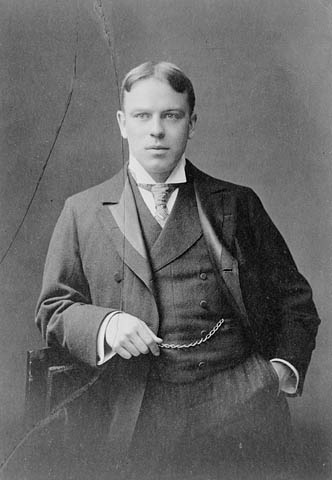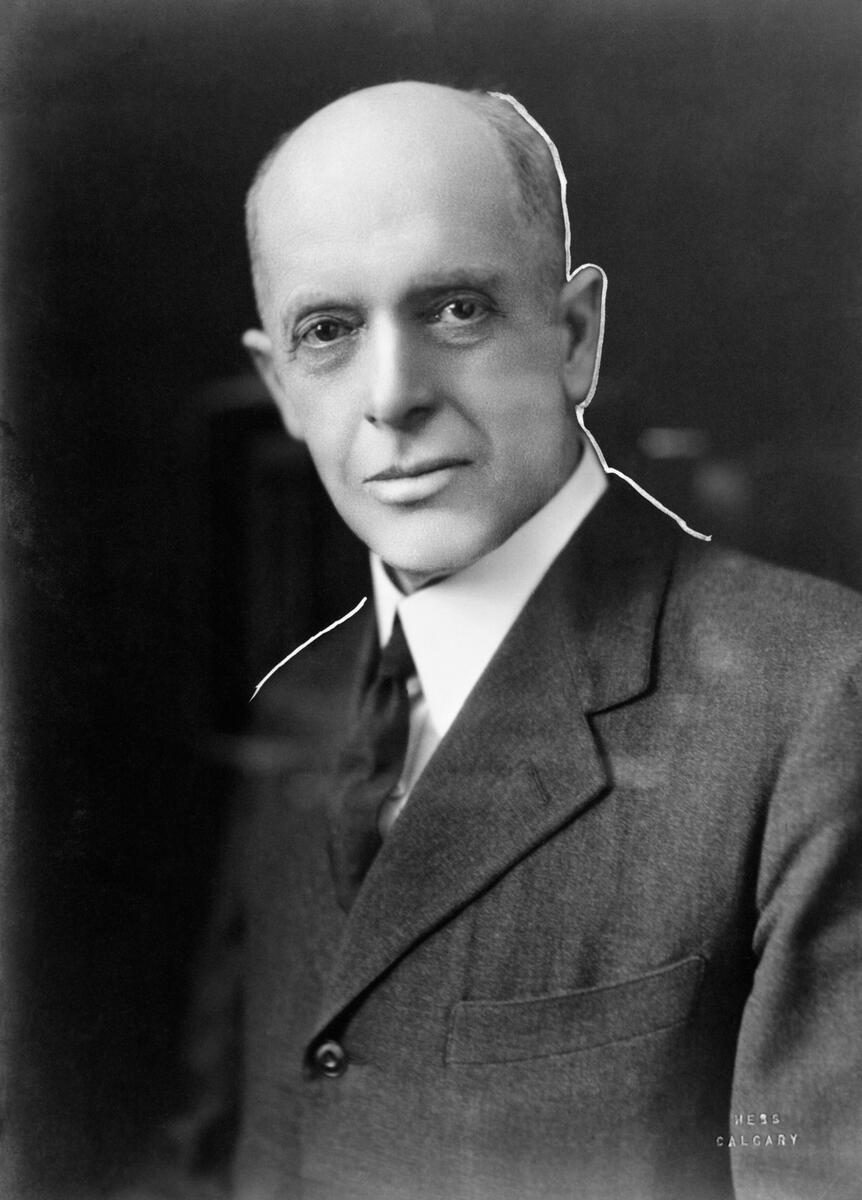|
Jean Côté
Jean Léon Côté (May 26, 1867 – September 23, 1924) was a prominent French-Canadian politician. He served as a member of the Legislative Assembly of Alberta from 1909 until 1923 sitting with the provincial Liberal Party in both government and opposition. He vacated his provincial seat when he was appointed to the Senate of Canada in 1923. He served until his death in 1924 sitting with the federal Liberal caucus. Early life Jean Léon Côté was born on May 26, 1867, in the village of Les Éboulements, Canada East, to Cléophas and Denise Côté. Côté was a surveyor and civil engineer by trade, and first visited the Edmonton area in 1886 as part of a survey crew. He returned to the East and trained as a Dominion Land Surveyor for the Department of the Interior, where he worked from 1893 to 1900. He participated in a number of high-profile projects, including the Alaska Boundary Commission. Political career Côté ran for a seat to the Alberta Legislature in the 1909 ... [...More Info...] [...Related Items...] OR: [Wikipedia] [Google] [Baidu] |
Les Éboulements
Les Éboulements is a municipality in the Capitale-Nationale region of Quebec, Canada. Its population centres include Les Éboulements (located along Route 362 on the plateau overlooking the Saint Lawrence River), Éboulements-Est (at the feet of Mount Éboulements), Cap-aux-Oies, Sainte-Marie-de-Charlevoix, and Saint-Joseph-de-la-Rive ( on the shores of the Saint Lawrence facing Saint-Bernard-sur-Mer). Saint-Joseph-de-la-Rive, formerly known as Les Éboulements-en-Bas and Quai-des-Éboulements, is the departure point for ferries to L'Isle-aux-Coudres. The municipality is member of the Association of Most Beautiful Villages of Quebec due to its country heritage and to the beautiful architecture and character of its houses. Geography Les Éboulements is located in the centre of the Charlevoix impact structure. Mount Éboulements (''Mont des Éboulements''), in the eastern part of the municipality, is considered the central rebound of the earth's crust following moments after th ... [...More Info...] [...Related Items...] OR: [Wikipedia] [Google] [Baidu] |
Mount Côté
Mount Côté is located on the border of Alberta and British Columbia. The mountain is named for Jean Côté, a Canadian politician. See also *List of peaks on the British Columbia–Alberta border A ''list'' is any set of items in a row. List or lists may also refer to: People * List (surname) Organizations * List College, an undergraduate division of the Jewish Theological Seminary of America * SC Germania List, German rugby unio ... References External links * Two-thousanders of Alberta Two-thousanders of British Columbia Canadian Rockies Peace River Land District {{FraserFortGeorge-geo-stub ... [...More Info...] [...Related Items...] OR: [Wikipedia] [Google] [Baidu] |
Quebec City
Quebec City ( or ; french: Ville de Québec), officially Québec (), is the capital city of the Provinces and territories of Canada, Canadian province of Quebec. As of July 2021, the city had a population of 549,459, and the Communauté métropolitaine de Québec, metropolitan area had a population of 839,311. It is the eleventhList of the largest municipalities in Canada by population, -largest city and the seventhList of census metropolitan areas and agglomerations in Canada, -largest metropolitan area in Canada. It is also the List of towns in Quebec, second-largest city in the province after Montreal. It has a humid continental climate with warm summers coupled with cold and snowy winters. The Algonquian people had originally named the area , an Algonquin language, AlgonquinThe Algonquin language is a distinct language of the Algonquian languages, Algonquian language family, and is not a misspelling. word meaning "where the river narrows", because the Saint Lawrence River na ... [...More Info...] [...Related Items...] OR: [Wikipedia] [Google] [Baidu] |
Alberta
Alberta ( ) is one of the thirteen provinces and territories of Canada. It is part of Western Canada and is one of the three prairie provinces. Alberta is bordered by British Columbia to the west, Saskatchewan to the east, the Northwest Territories (NWT) to the north, and the U.S. state of Montana to the south. It is one of the only two landlocked provinces in Canada (Saskatchewan being the other). The eastern part of the province is occupied by the Great Plains, while the western part borders the Rocky Mountains. The province has a predominantly continental climate but experiences quick temperature changes due to air aridity. Seasonal temperature swings are less pronounced in western Alberta due to occasional Chinook winds. Alberta is the fourth largest province by area at , and the fourth most populous, being home to 4,262,635 people. Alberta's capital is Edmonton, while Calgary is its largest city. The two are Alberta's largest census metropolitan areas. More tha ... [...More Info...] [...Related Items...] OR: [Wikipedia] [Google] [Baidu] |
William Lyon Mackenzie King
William Lyon Mackenzie King (December 17, 1874 – July 22, 1950) was a Canadian statesman and politician who served as the tenth prime minister of Canada for three non-consecutive terms from 1921 to 1926, 1926 to 1930, and 1935 to 1948. A Liberal, he was the dominant politician in Canada from the early 1920s to the late 1940s. King is best known for his leadership of Canada throughout the Great Depression and the Second World War. He played a major role in laying the foundations of the Canadian welfare state and established Canada's international reputation as a middle power fully committed to world order. With a total of 21 years and 154 days in office, he remains the longest-serving prime minister in Canadian history. Born in Berlin, Ontario (now Kitchener), King studied law and political economy in the 1890s and became concerned with issues of social welfare. He later obtained a PhD – the only Canadian prime minister to have done so. In 1900, he became deputy minister ... [...More Info...] [...Related Items...] OR: [Wikipedia] [Google] [Baidu] |
1921 Alberta General Election
The 1921 Alberta general election was held on July 18, 1921, to elect members to the 5th Alberta Legislative Assembly. It was one of only five times that Alberta has changed governments. The Liberal Party, which had governed the province since its creation in 1905, led by Charles Stewart at the time of the election, was defeated by a very-new United Farmers of Alberta political party. The UFA was an agricultural lobby organization that was contesting its first general election. It had previously elected one MLA in a by-election. Under the Block Voting system, each voter in Edmonton and Calgary could vote for up to five candidates, while Medicine Hat voters could vote for up to two candidates. All other districts remained one voter – one vote. No party ran a full slate of candidates province-wide. The UFA ran candidates in most of the rural constituencies, and one in Edmonton. The Liberal Party ran candidates in almost all the constituencies. The Conservatives ran a bare dozen ... [...More Info...] [...Related Items...] OR: [Wikipedia] [Google] [Baidu] |
1917 Alberta General Election
The 1917 Alberta general election was held on 7 June 1917 to elect members of the Legislative Assembly of Alberta. The Liberals won a fourth term in office, defeating the Conservative Party of Edward Michener. Because of World War I, eleven Members of the Legislative Assembly (MLAs) were re-elected by acclamation, under Section 38 of the ''Election Act'', which stipulated that any member of the 3rd Alberta Legislative Assembly, would be guaranteed re-election, with no contest held, if members joined for war time service. Eleven MLAs were automatically re-elected through this clause. (None were re-elected in the next election.) In addition, soldiers and nurses from Alberta serving in the First World War elected two MLAs. Two extra seats were thus added just for this election. The MLAs were non-partisan officially. But both Robert Pearson and Roberta MacAdams allied themselves to Labour and Non-Partisan League MLAs by showing social consciousness in regards the conditions avail ... [...More Info...] [...Related Items...] OR: [Wikipedia] [Google] [Baidu] |
1913 Alberta General Election
The 1913 Alberta general election was held in March 1913. The writ was dropped on 25 March 1913 and election day was held 17 April 1913 to elect 56 members to the 3rd Alberta Legislature. Elections in two northern districts took place on 30 July 1913 to compensate for the remote location of the riding. The method to elect members was under the First Past the Post voting system with the exception of the Edmonton district which returned two members under a plurality block vote. The election was unusual with the writ period for the general election being a very short period of 23 days. Premier Arthur Sifton led the Alberta Liberal Party into his first election as leader, after taking over from Alexander Rutherford. Premier Rutherford had resigned for his government's involvement in the Alberta and Great Waterways Railway Scandal but remained a sitting member. Sifton faced great criticism for calling the snap election, after ramming gerrymandered electoral boundaries through the le ... [...More Info...] [...Related Items...] OR: [Wikipedia] [Google] [Baidu] |
1909 Alberta General Election
The 1909 Alberta general election was the second general election held in the Province of Alberta, Canada on March 22, 1909, to elect 41 members of the Alberta legislature to the 2nd Alberta Legislature. The incumbent Liberal Party led by Premier Alexander C. Rutherford was re-elected to a majority government with 36 of the 41 seats in the legislature, and just under 60 per cent of the popular vote. The Conservative Party led by Albert Robertson formed the official opposition, with only two members, with Robertson was defeated in his own seat in High River. The remaining three seats were split between smaller parties and independents. Prior to the election, the Legislative Assembly passed ''An Act respecting the Legislative Assembly of Alberta'' in February 1909 which created an additional 16 seats in the Legislature, expanding from 25 members to a total of 41, and redistributed the boundaries of the provincial electoral districts. [...More Info...] [...Related Items...] OR: [Wikipedia] [Google] [Baidu] |
Minister Of The Interior (Canada)
The Minister of the Interior was the member of the Canadian Cabinet who oversaw the Department of the Interior, which was responsible for federal land management, immigration, Indian affairs, and natural-resources extraction. The position was created in 1873 by Statute 36 Victoria, c. 4, to replace the Secretary of State for the Provinces. The Act designated the Minister as ''ex officio'' the Superintendent-General of Indian Affairs. From 30 March 1912 to 9 February 1913, and from 31 December 1919 to 6 August 1930, the Minister of the Interior was also designated ''ex officio'' the Minister of Mines. It was superseded in 1936 by the Minister responsible for Indian Affairs and Minister of Mines and Resources. Ministers Key: See also * Secretary of State for the Provinces - post preceding the Minister of Interior * Secretary of State for Canada References External links * {{cite web, url=http://www2.parl.gc.ca/Parlinfo/Legacy/pages/DepHist.asp?lang=E&Dept=C&SubDept=All ... [...More Info...] [...Related Items...] OR: [Wikipedia] [Google] [Baidu] |





.jpg)
.jpg)